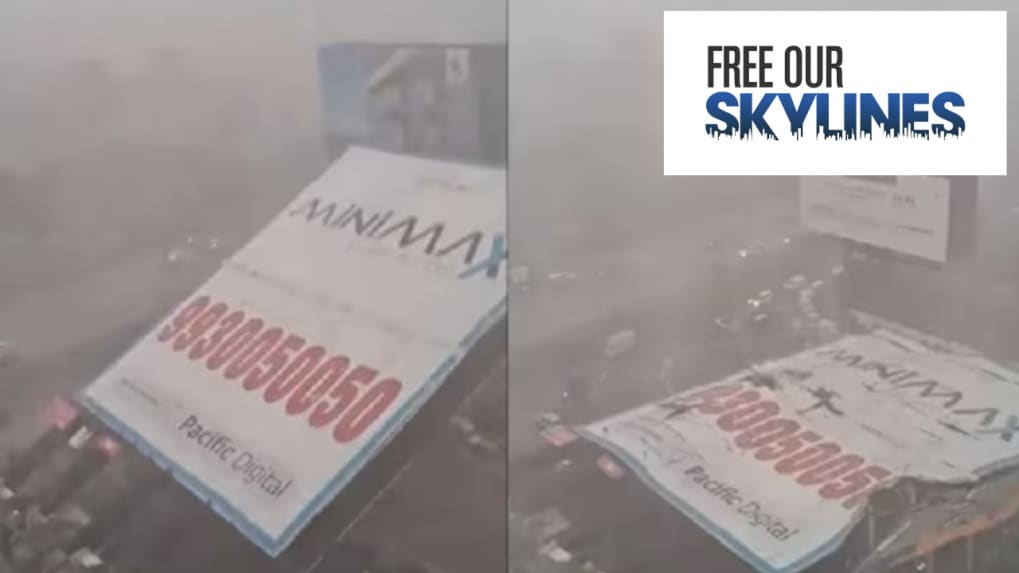Advertising
From Pink Slips to Silent Sidelining: Inside adland’s layoff and anxiety crisis

Despite repeated warnings and contempt notices from the Bombay High Court, political hoardings continue to mushroom across Mumbai, defacing public spaces and flouting legal directives. Social activists and citizens say the problem worsens during election season and festivals, with political party workers openly erecting massive displays in violation of the Maharashtra Prevention of Defacement of Property Act.
The issue came into sharp focus after the Bombay High Court, on December 19, 2024, issued contempt notices to over 25 political parties for disregarding its earlier orders to remove illegal banners and hoardings. A bench led by Chief Justice D.K. Upadhyaya slammed authorities after photographs showed unauthorised hoardings placed right outside the High Court itself.
“What can be more horrendous than this? Despite our judgment directing strict action against illegal hoardings, see where we are headed to. This is a very, very sad situation,” the bench had observed, noting that political parties had previously given undertakings not to engage in such practices.
Activists allege that many of these hoardings are funded by legislators under the guise of festival sponsorships, contributing to visual pollution, traffic hazards, and environmental damage. “BMC should file FIRs against political leaders to control this menace. If officials fail to act, disciplinary action should follow,” said Godfrey Pimenta of Watchdog Foundation.
“Despite a clear and binding order from the Bombay High Court, illegal hoardings continue to deface Mumbai. This is not just a matter of aesthetics — it’s about the blatant disregard for the rule of law,” Pimenta said.
“The Brihanmumbai Municipal Corporation (BMC) should immediately file FIRs against political party leaders responsible for this menace, especially during festivals when the problem intensifies. If BMC officials fail to take cognizance of these violations, then disciplinary proceedings should be initiated against them for dereliction of duty. Allowing such lawlessness to persist erodes public faith in civic governance.”
Pimenta added that citizen groups have been raising the alarm for years, but their appeals have been ignored.
“We have written multiple times to the government about the menace of illegal hoardings,” he said. “Yet, despite our efforts, politicians repeatedly choose to plaster the city with unauthorised displays. It’s a cycle of violation, token action, and then more violations — and it continues unchecked.”
Santosh Gholap, a social activist from Mumbai’s northern suburbs, echoed the frustration, emphasising the defiance of court directives. “The Bombay High Court has issued clear and repeated orders banning all illegal hoardings and directing strict action by both the Mumbai Police and the BMC,” Gholap said. “Despite this, political parties’ karyakartas are openly putting up large banners and billboards across the city, as though the law doesn’t apply to them.”
He alleged that some of these displays are financed under the pretext of cultural celebrations. “It is well known that many of these hoardings are funded by MLAs and MPs under the guise of sponsoring festivals,” Gholap claimed. “This continues even though the Maharashtra Prevention of Defacement of Property Act makes such acts punishable. What’s worse is that the funding is often presented as ‘public service’ when it is really political promotion.”
The problem persists despite tragic incidents, such as the collapse of an oversized illegal hoarding in Ghatkopar on May 13, 2024, that killed 17 people and injured over 60. In the aftermath, Maharashtra’s industries minister Uday Samant told the legislative assembly that over 1.09 lakh illegal hoardings had been taken down since the disaster, and annual audits were being planned.
Audit has been completed for over 9,000 hoardings and 51 persons have been booked for not cooperating with authorities during the audit, the minister said in response to questions about illegal hoardings from legislators across party lines.
“Hoardings will be audited every year and the first such audit will be conducted soon,” Samant said. The chief minister has asked the additional chief secretary of the home department to review the matter once a month, and the government was chalking out a new hoarding policy, he added.
Meanwhile, industry watchdogs like the Indian Outdoor Advertising Association (IOAA) are urging authorities to crack down on illegal hoardings, especially in a high-stakes election season.
“The civic body and election commission must ensure the city isn’t defaced with unauthorized banners and billboards,” said Praveen Vadhera, CEO of IOAA. “Political parties should communicate ethically through legal channels. It's time we preserve Mumbai’s skyline from election-time chaos.”
Even as illegal political hoardings spark legal and civic concerns, the upcoming Brihanmumbai Municipal Corporation (BMC) elections are set to fuel a sharp increase in outdoor advertising (OOH) revenues. Industry estimates point to a 10–15% rise in OOH ad spends during the polls, driven by heightened political visibility campaigns in India’s wealthiest municipal body.
“Election periods always lead to higher spending on outdoor advertising. For the BMC elections, we expect spends to grow by at least 10–15% compared to a regular year,” said Dr. Yogesh Lakhani, CMD of Bright Outdoor Media Ltd.
OOH’s share of total advertising expenditure in Maharashtra could rise to 10–12% during the civic polls, compared to the usual 5–7%, Lakhani added.
Among the 29 municipal corporations included in the election process are Pune, Nagpur, Thane, Nashik, Pimpri-Chinchwad, Navi Mumbai, Vasai-Virar, Chhatrapati Sambhajinagar, and Kalyan-Dombivli.
From purpose-driven work and narrative-rich brand films to AI-enabled ideas and creator-led collaborations, the awards reflect the full spectrum of modern creativity.
Read MoreLooking ahead to the close of 2025 and into 2026, Sorrell sees technology platforms as the clear winners. He described them as “nation states in their own right”, with market capitalisations that exceed the GDPs of many countries.